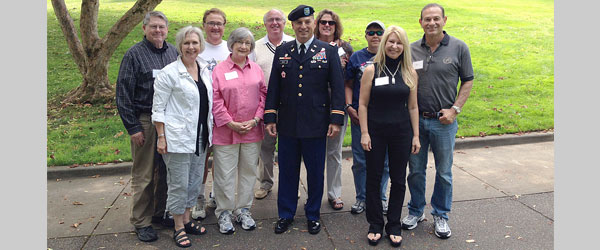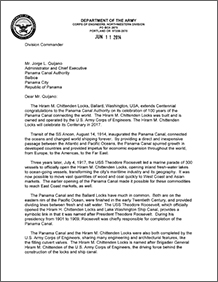
Washington State TRA members meet with Col John Buck, Commander Seattle Region Army Corps of Engineers on 16 August 2014 for a tour and historical overview of the Chittenden Locks in Seattle, Washington.
In honor of the centennial of the opening of the Panama Canal (August 15, 1914), considered by many as the greatest achievement of Theodore Roosevelt as president, the Washington State Chapter of the TRA (WATRA) held a special chapter visit and tour of the Washington Ship Canal and Chittenden Locks (often referred to as the Ballard Locks).
The Panama Canal and the Chittenden Locks are often compared. They are both on the eastern rim of the Pacific Ocean, they both provide a transition for large ships between fresh and salt water, they were both finished in the early years of the twentieth century, and they are among the largest lock systems in the world. Just as the Panama Canal connects the Atlantic and Pacific Oceans, the Chittenden Locks provides a link for ships between the salt water of Puget Sound and the fresh water of the Ship Canal, which connects eastward to Lake Union and Lake Washington. The Panama Canal is characterized by three sets of double locks similar to the Chittenden Locks which has three pairs of gates: a single pair at each end and another in the middle.
As early at the 17th century, damming of waterways was identified as eliminating many sub-species of Salmon and Steelhead by blocking access to their originating rivers and streams. Although many laws and resolutions were passed in 1880s and 1890s, there was little to no enforcement. Theodore Roosevelt’s national emphasis on conservation is attributed to popular support for enforcement of these laws and may have led to preservation of this national treasure. Although the current version of Salmon ladder in the Chittenden Locks was built in 1976, previous versions date back to the original design by Chittenden in 1911. The Chittenden Locks may well have the longest continuously operating set of salmon ladders and chutes in the western United States.
Washington State TRA members met the Army Corps of Engineers Public Affairs Officer, Bill Dowell, in front of the Visitor Center for a custom tour of the Chittenden locks. The
tour started with Chittenden Locks historical exhibits and a Corps of Engineers movie on the history of the canal and locks. We then walked across the locks seeing the locks in action. Walking across the walkways on top of the lock doors, we viewed sailboats, motorboats, tugs, barges and yachts passing through, as the locks’ water levels were adjusted to allow their safe passage. We learned of the specially-constructed chutes for young salmon to traverse the locks as they swim to the Pacific. Then we saw the Salmon Ladder and the life cycle of the various species of salmon which migrate through the locks as they return home via Puget Sound and Lake Washington to find their rivers of origin.
Colonel John G, Buck, commander Seattle District, U.S. Army Corps of Engineers read a special letter of greeting and congratulations, from Brigadier General John S. Kem, Commander of the Northwest Region, Army Corps of Engineers to the Panama Canal Commission. Col Buck followed this with an overview of the Army Corps of Engineers’ areas of responsibility in Puget Sound. Washington Chapter member Gene Kopelson then presented a historical lecture about Theodore Roosevelt and Hiram Chittenden.
David Bryant, WATRA President
Gene Kopelson, event chairman







